Oc Eo – famous archaeological culture in the South
President of the Vietnam Academy of Social Sciences, Associate Professor Dr. Bui Nhat Quang said that in 2015, the Prime Minister assigned the task to the Vietnam Academy of Social Sciences to organize the implementation of the Project “ Research Oc Eo – Ba The archaeological relic site, Pagoda Foundation (Southern Oc Eo Culture)” referred to as Oc Eo Project.
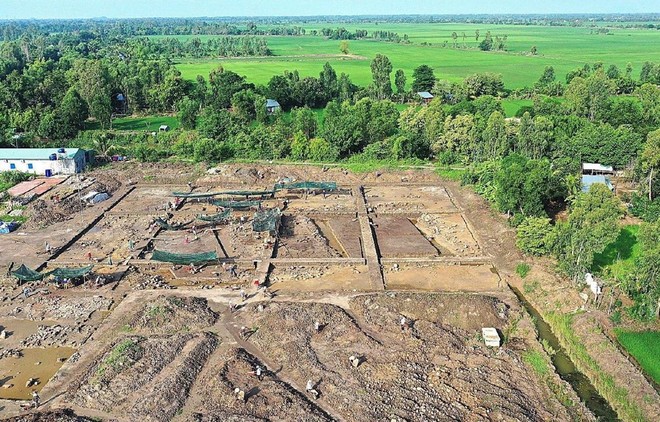 |
| The Oc Eo cultural archeology project at the Oc Eo-Ba The relic and the Pagoda Foundation is conducted by three leading units in archeology in Vietnam: Institute of Imperial Citadel Research, Institute of Archeology and Institute of Science. society in the Southern region. |
The main task of the Project is to excavate and research the archeology of Oc Eo culture at relics in Oc Eo – Ba The (Thoi Son district, An Giang province) and the Pagoda Foundation relic (Hon Dat district, Kien province). Giang) to collect documents and clarify the history of formation and development of Oc Eo culture and the Funan kingdom, and at the same time research more deeply about the location, role and importance of Oc Eo ancient town. in the history of Vietnam, Southeast Asia and Asia; providing a scientific basis for planning, conservation and value promotion, especially for the preparation of UNESCO nomination dossier to consider recognizing the Oc Eo – Ba The relic site and the Pagoda Foundation as a World Heritage Site. world cultural products.
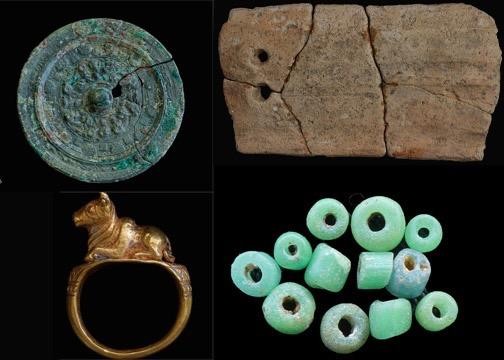 |
| Priceless artifacts found through archaeological excavations at Oc Eo and Platform Pagoda from 2017-2021 |
The excavation results have discovered many new scientific issues, proving more clearly and convincingly the characteristics and properties of the “ancient urban area” on Oc Eo field, which was a gathering place along canals with living creatures. Outstanding agricultural and commercial design, highly developed cultural exchanges and maritime trade, linking many regions of the world at that time.
In addition, excavation results at Ba The mountain also discovered a large-scale complex of religious and religious architectural relics, providing a quite vivid picture of the major religious center of the Phu kingdom. South and the very unique cultural life of Oc Eo ancient town in history.
Oc Eo is a famous archaeological culture in the South, Vietnam and the region, closely related to the history of formation and development of the Funan kingdom in the early AD.
Oc Eo culture with the concept and connotation of “Oc Eo Culture” was first discovered by L. Malleret (L. Malleret, 1959). Through historical excavations in the dry season of 1944 and focused research in the West of the Hau River, this culture was then identified as the material foundation, the “sea part” of the Funan kingdom. and existed closely with this kingdom from about the 1st to the 7th century.
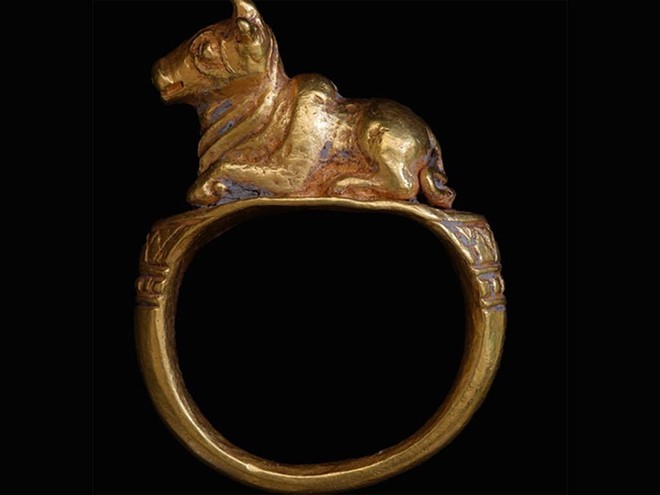 |
| The gold Nandin bull ring has just been recognized as a National Treasure at the end of 2021 |
It can be said that L.Malleret was the first person to lay the foundation for research on Oc Eo culture in the South, Vietnam. In his research works, he initially clarified many basic issues of this culture such as the origin of Oc Eo culture, identifying issues of maritime trade relations, and cultural relations with China. China, India, Mesopotamia, Rome and the island region… as well as finding ways to explain the decline of the Funan kingdom after the 7th century.
Inheriting the research achievements of Western scholars, since 1975, Vietnamese scientists have made efforts to search, discover and research to fundamentally restore the appearance of Oc culture. Eo from spatial distribution, indigenous origin of culture through new archaeological findings. Especially to basically determine the historical, cultural and artistic value of Oc Eo culture from hundreds of relics that have been explored and excavated and thousands of valuable relics being kept at the museum. Southern provinces.
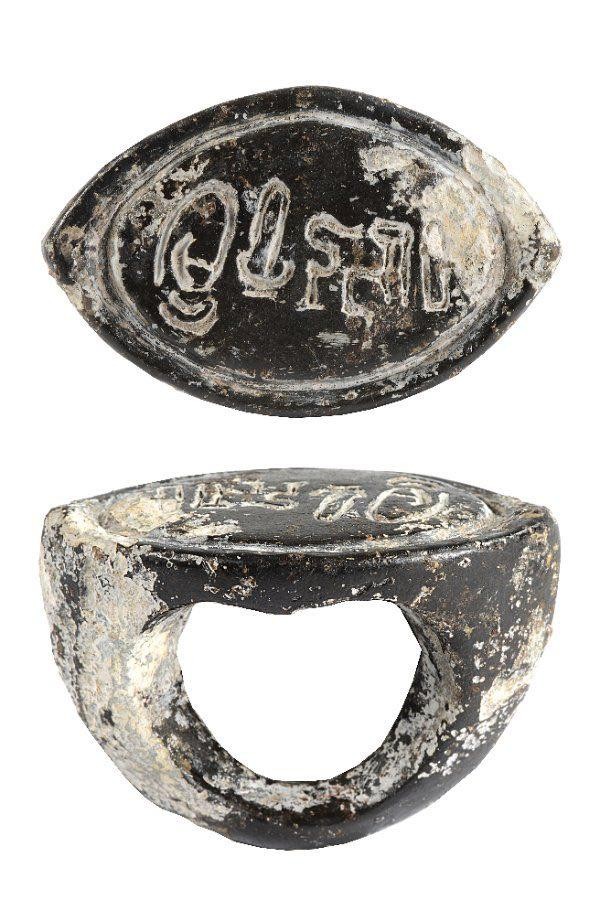 |
| A ring belonging to the Oc Eo Culture of the 1st to 7th centuries |
On the basis of new discoveries, Vietnamese scientists have established the development process of Oc Eo culture and the Funan kingdom, and gradually clarified many related scientific issues such as socio-economic structure, cultural exchange relationships and intra-regional and international trade through maritime trade.
Revealing countless precious antiques
During 4 years of excavation and research at Oc Eo Ba The site and Platform Chua site, scientists found a total of 2,790,912 valuable artifacts. In particular, at the Oc Eo – Ba The relic site, 2,376,466 artifacts were found, of many different types and materials. In particular, Indo-Pacific glass beads have a very large number of 1,038,131 beads of many different colors and sizes, along with 1,337,910 pieces of terracotta pottery, 17 religious artifacts, 395 production tools. and living activities along with some special artifacts such as bronze mirrors, musical instruments… Artifacts collected are mainly all kinds of household and production utensils, along with all kinds of jewelry and religious worship objects. and almost no weapons. This clearly reflects the nature of an urban area with agricultural and commercial livelihoods of the Oc Eo – Ba The relic site in the past.
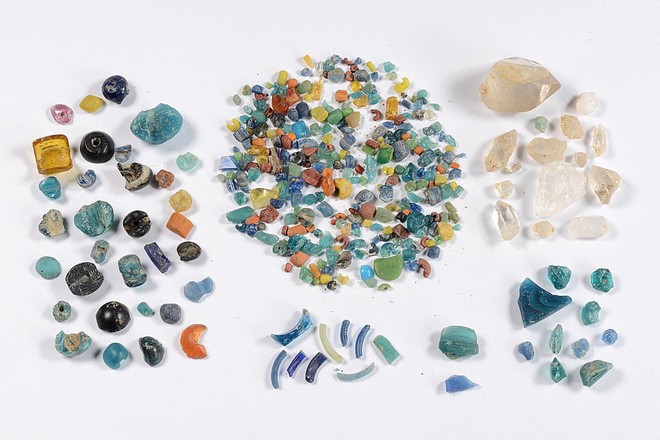 |
| Gemstone jewelry |
The Pagoda Foundation relic site found 414,446 archaeological artifacts, including ceramics, metal objects, jewelry, glass objects, musical instruments… Among them, there are many types of relics that are household utensils ( all kinds of ceramic, stone or wooden utensils and utensils), all kinds of handicraft and agricultural production tools (jewelry molds, crucibles, weaving bobbins, weaving tools, etc.) pottery making, grinding tables, pestles, mortars…), especially among them there is a significant amount of foreign ceramics.
Among the discovered relics, two were quickly recognized as National Treasures in the latest recognition at the end of 2021. They are a stone slab engraved with a meditating Buddha image and a gold Nandin bull ring. .
Outstanding values to become a World Heritage Site
From the remaining material manifestations of the Oc Eo – Ba The archaeological site, we have proven the existence of a culture associated with the Funan kingdom – a rich and powerful kingdom in Southeast Asia from the beginning of the Common Era. until the 7th century. Oc Eo – Ba The archaeological site was the main transit point between the Indian Ocean and the Pacific Ocean through the Kra Strait in southern Thailand at that time. This heritage contains historical, cultural and scientific values that represent one of the disappeared ancient civilizations.
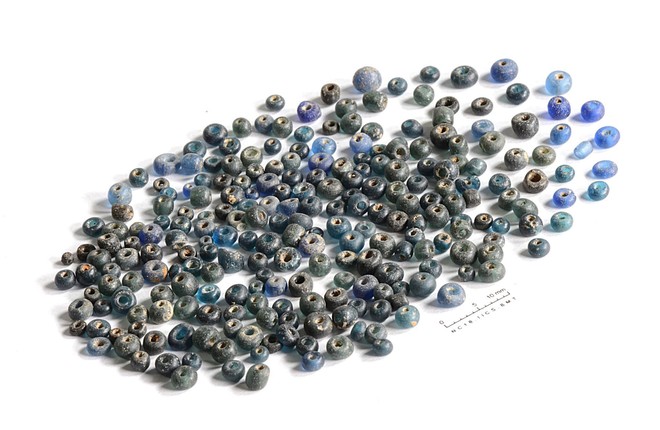 |
| The number of beads found is up to millions |
Scientists implementing the Oc Eo Project have agreed and made comments based on research documents and relics: In the first centuries AD, for the first time in history, an economic system was established. The world was established through a number of Asian trade routes connecting China, Southeast Asia through India, the Persian Gulf, the Mediterranean… In that system, Oc Eo-Ba The has emerged as a region has the most developed production and trade level in Southeast Asia, connecting trade between the West and the East.
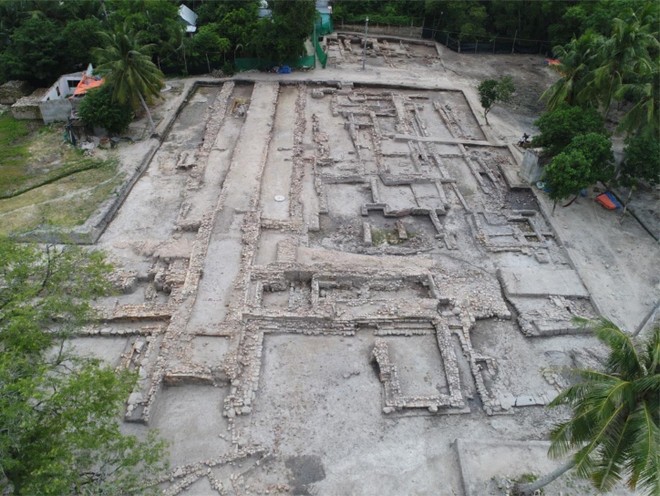 |
Oc Eo ancient town with large craft workshops, high technical level, both multi-disciplinary and specialized, especially jewelry, glass processing, gemstones… Products produced here has been consumed in countries, regions and territories that today are Southern Thailand, Northern Malaysia, Java, Central Vietnam, China, Korea… This is also a point of interference, cultural adaptation and techniques of nations originating from India and other countries in the Mediterranean, Indian Ocean, Pacific Ocean… through the products of trade and international relations during the prosperous period of the Funan Kingdom from the 2nd to the 7th century.
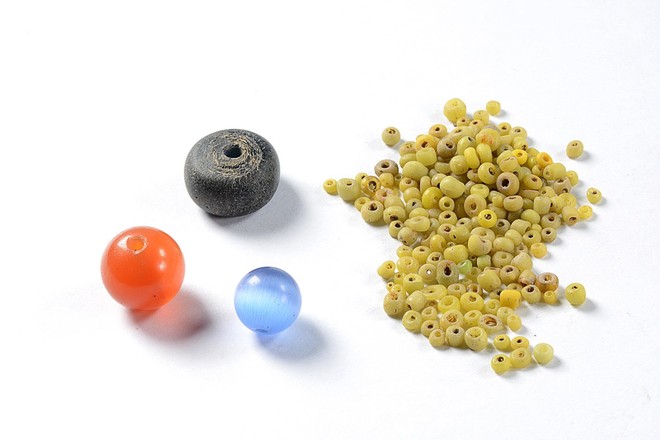 |
In a relatively separate natural and social space, the indigenous nature of Oc Eo culture was formed in a long process of movement and development from the 2nd – 1st centuries BC to “post-Oc Eo”. Around the 8th-9th centuries AD, that indigenousness was expressed through pottery, wooden and stone tools; Religious architectural construction techniques, housing styles, burial methods of the dead… Many artifacts demonstrate a high level of artistic ideology such as wooden Buddha statues, sandstone statues; ceramic products with motifs, stone slabs with carved patterns, ancient inscriptions… in which wooden standing Buddha statues are typical of the unique Oc Eo art style.
Living in the low plains, exposed to the sea, seasonal flooding, saltwater intrusion… the ancient Oc Eo community knew how to adapt to the environment, correctly applying natural laws to survive both. about physical and spiritual activities. Collected wooden pillars, beams, railings, etc. along with many traces of decomposed wood on Oc Eo field clearly show the traditional form of residence of the people. Oc Eo residents in the past mainly settled on wooden stilt houses around high mounds at the foot of the mountain. They dug and filled many canals to exploit land for seasonal crops.
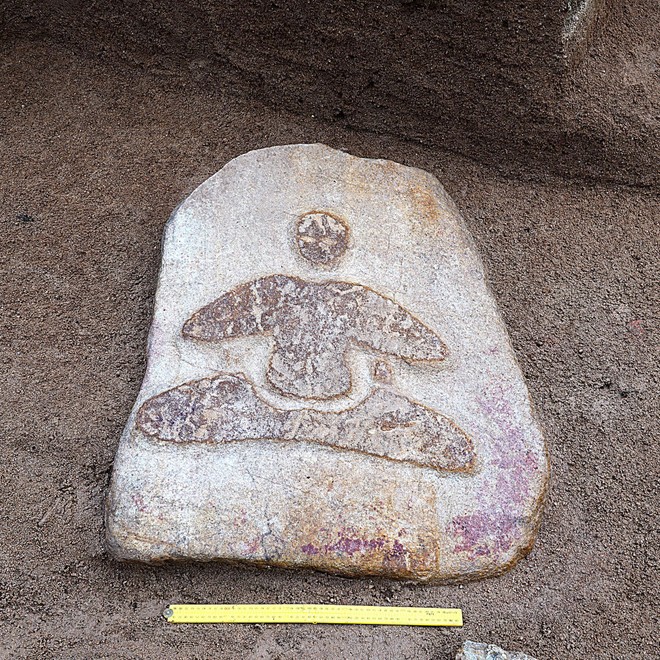 |
| National treasure stone slab engraved with a meditating Buddha image |
Since the scientific publications of L. Malleret (1959-1962) on Oc Eo culture, there have been hundreds of domestic and foreign scientific works on this culture and the archaeological relics of Oc Eo – Ba The. was announced; Many in-depth seminars are organized. In 1997-2002, the French School of the Far East (EFEO) coordinated with Vietnamese archaeologists to conduct fieldwork, surveys and archaeological excavations on a large scale from the slopes of Ba The mountain to the Oc field. Waist. Implementing the project Research on archaeological relics of Oc Eo-Ba The, Pagoda Foundation (Oc Eo Culture) of the Vietnam Academy of Social Sciences from 2017 to 2020, more than 10 archaeological relics have been discovered. continuous excavation on a large scale.
In 2012, the Oc Eo – Ba The archaeological site was ranked by Vietnam as a special national monument; In January 2021, there was a Decision on planning to preserve and restore monuments for the entire 433.2 hectares within the special national relic site.
Publishing the publication “Oc Eo Culture – New archaeological discoveries at Oc Eo-Ba The relics and Pagoda Foundation 2017-2020”.
Based on the results achieved by the Project, the Vietnam Academy of Social Sciences and the Project’s Steering Committee decided to compile and publish the publication “Oc Eo Culture – New archaeological discoveries at the site”. Relics of Oc Eo-Ba The and Pagoda Foundation 2017-2020″. The book aims to initially announce the results of the project’s implementation. Including drawings, photos of relics and archaeological artifacts at the Oc Eo-Ba The and Pagoda Foundation archaeological sites, there are also many high-quality satellite and flycam photos of the sites. archaeological sites under the Oc Eo Project, as well as 3D models of relics reconstructed from comparative research results.
The book includes 4 main chapters: “The Oc Eo-Ba The relic site and the Pagoda Foundation in the history of researching Oc Eo culture in the South”; “Archaeological findings at Oc Eo-Ba The relic”; “Archaeological findings at the Temple Foundation Relics”; and “Overall assessment of excavation results and archaeological research at Oc Eo-Ba The and the Temple Foundation in 2017-2020.” The book is co-edited by three leading archaeological researchers from three agencies under the Vietnam Academy of Social Sciences: Associate Professor, Dr. Bui Minh Tri, Director of the Institute of Imperial Citadel Studies; Dr. Nguyen Gia Doi, Acting Director of the Vietnam Institute of Archeology; Dr. Nguyen Khanh Trung Kien, Deputy Director of the Institute of Social Sciences of the Southern Region.
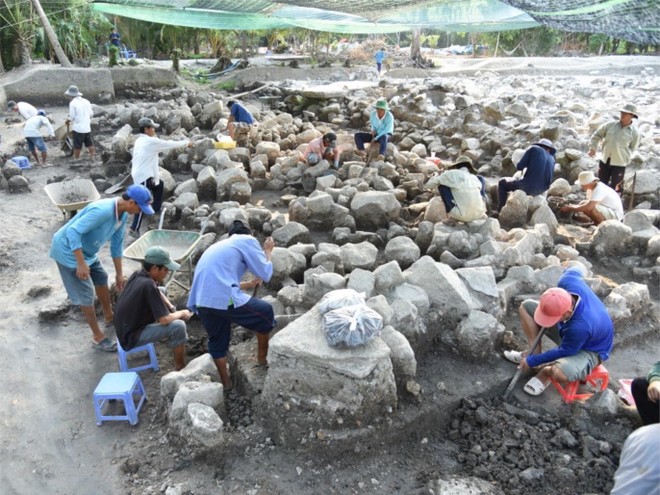 |
| The archaeological excavation of Oc Eo-Pagoda Foundation took place over 4 years |
Associate Professor, PhD. Bui Van Liem, Editor-in-Chief of Archeology Magazine, Member of the National Cultural Heritage Council commented: This is a work announcing basic results in implementing the Project. The book has introduced deeper and broader research points and new scientific perspectives: affirming that Oc Eo – Ba The is a population center, urban center, economic center, and important religious center. importance of Oc Eo culture – Funan Kingdom; Greater awareness of the nature and functions of the two subdivisions: the Religious Center on the slopes of Ba The Mountain and the Ancient Urban Area on Oc Eo Field; Clarifying the functions of Oc Eo urban space, clarifying the concepts of “urban” and “urban port”. From there, it is affirmed that Oc Eo has the role of an “urban area”…; Clarifying the role of Oc Eo urban area in the international trade system; New awareness of the Pagoda as a large population and religious center that flourished during the 4th – 6th centuries. It was also the place where many cultural and religious activities of the community took place. The pagoda’s foundation has a close relationship with the ancient town of Oc Eo, Ba The religious center and surrounding areas.
Dr. Pham Quoc Quan, Former Director of the National Museum of History, said that: The comments on the Oc Eo – Ba The relic site as well as the Pagoda Foundation, although initial, have partly confirmed the contributions Important and specific science, clarifying more clearly the nature, functions, dates and roles of the three relics in Oc Eo culture. Those observations are also directional suggestions for subsequent research programs and projects on Oc Eo culture in the Mekong Delta in particular and the entire Funan Kingdom in general. Many ideas in these comments can be exploited to build criteria in the dossier submitted to Unesco to register the Oc Eo Culture as a World Cultural Heritage, when the following documents are convincingly clarified. for the criteria to be developed.





